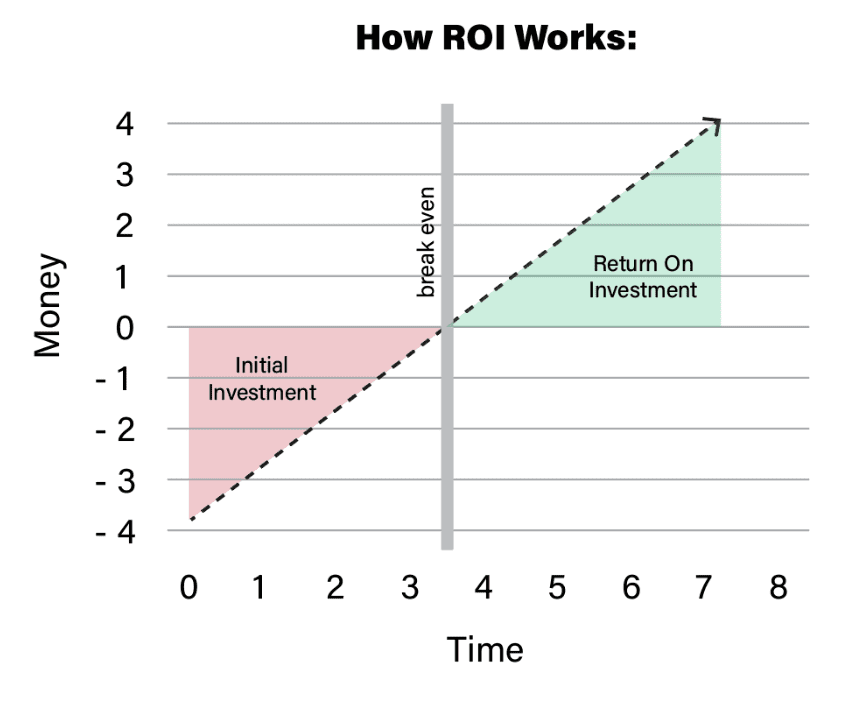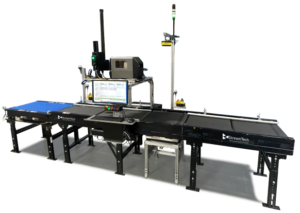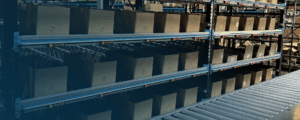As an Operations professional, you’re likely already well-versed in the intricacies of your operation and can pinpoint areas where bottlenecks are hindering your progress. Identifying the problem is the first step, but the path to a solution can often seem cloudy, especially when it involves significant investment and the adoption of automation systems.
Warehouse automation promises to not only streamline operations, but also to drastically improve efficiency and scalability. But the pressing question remains: Is the investment worth it?
StreamTech participated in an MHI Industry Leadership podcast on this topic: Navigating ROI in Automated Ecommerce and Fulfillment Processes. Whether you’re grappling with the decision to automate or seeking to optimize your existing setup, we’ll help you make informed, strategic decisions to propel your business forward.
The Concept of ROI in Warehouse Automation
Return on Investment (ROI) is a key financial metric used to evaluate the efficiency of an investment or to compare the efficiencies of different investments. In the context of warehouse automation, ROI helps determine the financial return you can expect from investing in automation technologies compared to the cost of the investment. This calculation is essential in making informed decisions, as it provides a quantifiable measure of the potential benefits relative to the cost.
Key Components in Calculating ROI
Calculating ROI involves several components, each contributing to the overall financial picture of the investment.
- Initial Investment: This is the total cost of implementing warehouse automation. It includes the price of equipment, software, installation, and any modifications needed in the warehouse infrastructure.
- Operational Cost Savings: One of the primary benefits of automation is the reduction in operational costs. This includes savings from reduced labor costs, lower error rates, and decreased waste. For instance, automated systems can operate continuously without the need for breaks, leading to higher productivity and reduced labor expenses.
- Productivity Gains: Automation typically leads to increased efficiency in warehouse operations. This is quantified in terms of higher throughput, better inventory management, and faster processing times. These gains translate into an ability to handle more orders, improve customer satisfaction, and potentially increase sales.
Time Frame for ROI
The time frame to achieve ROI from warehouse automation can vary significantly based on the scale of investment and the nature of operations. Many of the clients we work with are seeking to justify the investment by showing a return within 2 years or less. Some larger projects may have an extended timeframe, but 2 years is common.
It’s important for businesses to set realistic expectations and consider long-term benefits, as the initial investment in automation can be substantial, but the ongoing operational savings and productivity gains can lead to significant financial benefits over time.
How to Calculate Warehouse Automation ROI
Step 1: Identify Costs
When considering warehouse automation, it’s crucial to thoroughly understand and account for all associated costs. These typically include:
- Equipment Costs: The price of purchasing or leasing automation equipment such as robots, conveyor belts, automated storage and retrieval systems, and software solutions.
- Installation Costs: Expenses related to setting up and integrating automation equipment into your current warehouse infrastructure. This can also include costs for modifying existing layouts to accommodate new technology.
- Training Costs: Investment in training your staff to operate and maintain the new systems. Adequate training is essential for ensuring the efficient use of automated technology.
- Maintenance and Upkeep: Regular maintenance costs to ensure the equipment operates efficiently and has a longer lifespan. This can include spare parts, remote technical support, and annual maintenance – all offered through our Lifetime Services team.
Step 2: Quantify Benefits
To effectively calculate ROI, it’s important to quantify the benefits that warehouse automation brings to your operation. Some key benefits include:
- Labor Savings: Automation reduces the need for manual labor, especially for repetitive and physically demanding tasks. Calculate savings by comparing current labor costs with projected costs post-automation.
- Reduced Error Rates: Automation minimizes human errors in processes like picking and packing. Quantify this benefit by estimating the current cost of errors and how much you could save with more accurate automated systems.
- Increased Throughput: Automated systems can process orders faster and more efficiently, leading to increased throughput. Quantify this by estimating the potential increase in order volume and the corresponding revenue growth. The increase in throughput typically means orders are processed faster, which means fewer hours worked – and the head room to grow the business, which leads to the next benefit, scalability.
- Scalability: One of the most significant long-term benefits of warehouse automation is scalability. Automation solutions can be scaled up or down based on demand, providing flexibility and resilience in response to market changes or business growth. This adaptability is critical for maintaining operational efficiency and ensuring that your investment in automation continues to pay off as your business evolves. Quantify scalability by evaluating how automation can accommodate future growth without substantial additional investments.
ROI Formula and Example Calculation
The basic formula for ROI, across all industries and investments is below:

Before we run an actual ROI example, we need to understand that the first year will NOT necessarily produce a viable return on the investment. So when we do the math, initially it will appear as though the benefits do not outweigh the costs – because of initial investment. However, extending the savings timeline beyond the first year, you see that it delivered a payoff for the investment.

Over time, the continuous annual savings and additional revenue should surpass the initial costs, leading to a positive ROI over time.
Let’s assume the following for a warehouse automation project in the amount of $400,000:
Benefits:
- Annual Labor Savings*: $280,000
- Annual Savings from Reduced Errors: $20,000
- Additional Annual Revenue from Increased Throughput: $80,000
Total Annual Benefits: $280,000 (labor) + $20,000 (errors) + $80,000 (throughput) = $380,000
Costs (1st year):
- Equipment, installation, training, maintenance: $400,000
If we calculate the ROI for the first year:

So we see, based on the provided information, the calculated Return on Investment (ROI) for the warehouse automation project is -5%. Or to put this number in a positive light – the return was enough to cover 95% of the initial investment in the first year.
As we explained above, it’s important to consider that warehouse automation is typically a long-term investment. Over time, the continuous annual savings and additional revenue will surpass the initial costs, leading to a positive ROI in subsequent years.
*$15 an hour ($30k annually), or $19 an hour ($40k), if you have 6 to 8 employees doing weigh, dimension, labeling, sortation, that’s an average of $280k.
The Long-Term Value of Investing in Warehouse Automation
When considering warehouse automation, the initial investment might appear daunting. However, this investment is often justified by the substantial long-term benefits and cost savings that automation brings to business operations over time.
Improved Efficiency and Reduced Labor Costs
The primary advantage lies in drastically improved efficiency and productivity. Automated systems consistently outperform manual labor in speed and accuracy, leading to increased throughput and customer satisfaction. This boost in productivity directly impacts your revenue and market position.
Additionally, the substantial reduction in ongoing labor costs, including wages and associated expenses, balances out the upfront costs. Automation ensures consistent quality and reduces error rates, enhancing brand reliability and customer trust.
Reduced Shipping Backcharges & Errors
Improperly priced and processed packages can harm a business’s bottom line through increased expenses and potential delivery delays. Inaccurate assessment of carrier information may lead to returned mail or back charges, accumulating extra fees, especially for large-scale shipping. Underestimating or overestimating package weight and dimensions incurs additional costs.
For example, USPS introduced fees in April 2022 to address non-compliance with correct postage and dimensional size, following changes by UPS and FedEx in 2015. Charges for missing or incorrect dimensions range from $0.25 to $1.50, which may seem minimal but can accumulate significantly for businesses processing numerous orders.
To illustrate, shipping 7,000 packages per hour, with half incurring back charges, could result in a total fee cost of $112,500. Accuracy in dimweight is crucial to avoid such expenses. Inadequate postage can also lead to delays, damaging a company’s reputation and customer satisfaction. PwC reports that in the U.S., 17% of consumers stop purchasing after one bad experience, and 59% after several.
Scalability and Reliability
Another critical aspect of warehouse automation is its scalability. As your business grows, automated systems can be efficiently scaled to accommodate increased demand without the proportional cost increase associated with scaling a human workforce. This scalability is vital for expansion in competitive markets.
Implementing automation will give you the agility to adapt quickly to market changes, providing a significant competitive advantage.
Conclusion
If you are considering warehouse fulfillment automation and would like to discuss the investment costs and the potential advantages, StreamTech has engineers who can help you. Our team would be glad to develop a concept, explain the advantages, and develop a case that you can present to your leadership to improve your fulfillment processes.


